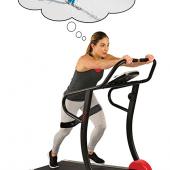In the Flesh
Soft-tissue injuries & sports massage therapy.
Everyone experiences a soft-tissue injury at some time or another during the course of his or her life. The term “soft tissue” generally refers to muscle, tendons, ligaments, fascia, and skin. The majority of such injuries are likely to be short-term, uncomfortable inconveniences rather than major issues and, given time and the prompt use of the RICE (Rest, Ice, Compression, Elevation) protocol, are likely to heal themselves. However, there is also the unfortunate possibility of a major injury that will require more immediate medical intervention and rehabilitation. Somewhere between these two scenarios is the type of problem that constitutes a “minor musculoskeletal” or “soft tissue” injury.
By general definition, a minor musculoskeletal injury is one that does not require surgical intervention. This type of injury can still be extremely painful, and if not treated at an early stage, could lead to more problems. This may then affect physical and psychological well-being, work capability, quality of life, or athletic performance.
When someone injures an extremity, he or she will favor the injured part because of pain, swelling, and bruising—limping after a sprained ankle, for example. This will lead to abnormal loads being applied to the body’s musculoskeletal structures, as movement patterns are altered to compensate for the injury. This compensation can often be so subtle that we may not even realize it! However, by adopting this “new” method of movement, the body may begin to develop chronically tight muscles or fascia, trigger points, adhesions, or scar tissue, therefore making matters worse, not better.
This is where the use of sports massage really comes into its own, as it is typically more focused on the specific muscles and soft tissues that have become compromised due to injury or overuse. Alleviating tight, sore muscles, while an extremely important function of sports massage, is only part of the overall picture. It can also be used to treat the following common soft tissue complaints quickly and effectively.
Edema (Swelling)
The amount of edema (and bruising) that is generated following a soft tissue injury depends on the severity of the injury. Edema limits the mobility of an injured body part by making movement extremely painful, so normal massage techniques are generally too invasive during the acute stage. However, a powerful (but light) technique called Lymphatic Facilitation can be used to help move greater amounts of fluid away from the problem area. This allows the injury to heal faster, as it decreases pain and allows increased range of motion.
Adhesions
When a muscle or muscle group is overworked to exhaustion and not allowed to recover before being asked to do the same activity all over again, micro-tears occur either in the muscle fiber or in the surrounding fascia or both. The body then generates a sort of “super glue” to repair the micro-tears, which, as it accumulates, sets up the possibility of decreased flexibility within the muscle and the formation of painful trigger points. A number of the techniques utilized in sports massage are very successful in addressing this problem, by first “breaking up” the adhesions and then lengthening the affected muscle or fascia.
Scar Tissue
During the repair process, scar tissue forms to “plug the hole” at the injury site. Ideally, the scar tissue would lay down in the same direction and depth as the fibers of the muscle it is helping to repair; it would be flexible and allow the muscle to contract and relax without any difficulty. No such luck. Scar tissue has this amazing capacity for sticking to everything around it, just to make sure the “hole“ is well and truly plugged, and then it proceeds to shrink as it matures! This means that the injured muscle will become increasingly inflexible and tight, and could result in the body part having a severely restricted range of motion. By using a technique called Cross Fiber Friction; the sports massage therapist can help produce a strong, pliable scar with a more parallel fiber arrangement and fewer connections to other surrounding structures. It will also decrease the likelihood of re-injury at the same site.
Trigger Points
Travell & Simons, in their definitive Myofascial Pain and Dysfunction—The Trigger Point Manual, defined trigger points as “a focus of hyperirritability in a tissue that, when compressed, is locally tender and, if sufficiently hypersensitive, gives rise to referred pain and tenderness.” Trigger points can be found within any of the soft tissue structures, but are most commonly located within a tight muscle band that has become ischemic (lack of blood flow) over a period of time due to overuse or trauma. Neuromuscular therapy and muscle release techniques are extremely effective tools that can be utilized by a sports massage therapist to deactivate these hyperirritable “nodules,” which will reduce muscle tension and pain, and allow increased movement.
Sports massage is not just one modality, but a collection of manual techniques that can be used at any time during the course of a treatment session. These might include: Swedish massage, lymphatic facilitation, positional release therapy, neuromuscular therapy, myofascial release techniques, muscle release techniques, and muscle energy techniques to name but a few. Each technique has its own application within the healing process (acute/sub-acute/chronic), and is able to elicit its own specific physiological/physical response from the injured tissue. A well-trained and experienced sports massage therapist will be able to utilize these (and other) modalities, either individually or in combination, to achieve the best outcome for the client.
The term “sports massage” doesn’t mean this particular manual therapy should be used only by athletes. Everybody is physically active in his or her own way, from Mom chasing her two-year-old around, to the computer operator sitting in front of a workstation for hours at a time, to the construction worker, the weekend warrior, or world-class athlete. Therefore it follows that everyone will (sooner or later), because of recreational or work activity, experience some sort of soft tissue injury that could be helped by sports massage therapy.
Paul Weston NCTMB, LCSP (Phys.) is a partner in Sports & Orthopedic Massage Associates, LLC of Bozeman (586-3552), and a two-time finisher of the Ironman Canada Triathlon.










